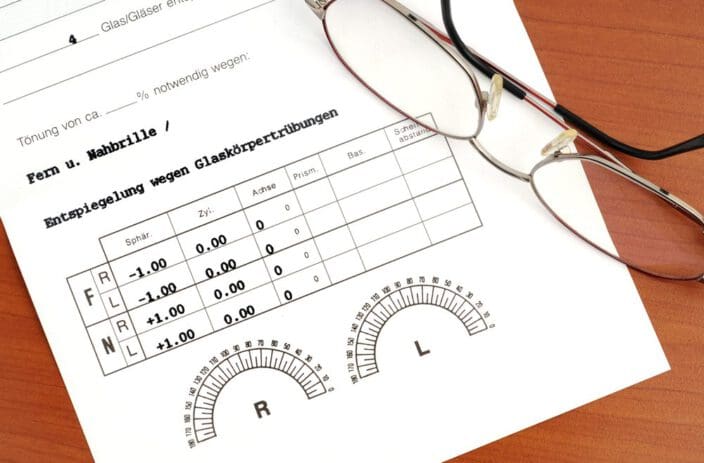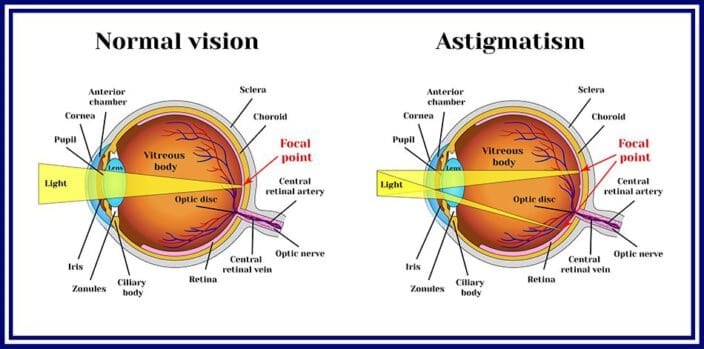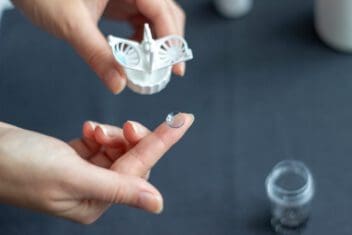Further Reading
Everything to Know About Your Eye Prescription
Home / Everything About Glasses /
Last Updated:
Eye prescriptions measure the strength of each eye. The measurements are expressed in the form of diopters.
Various other measurements determine the strength of the necessary corrective devices, to ensure that vision problems are fully addressed.
Table of Contents
A prescription for eyeglasses cannot be used to purchase contact lenses, and vice versa.
As a consumer, you have the right to take your eye prescription and shop around for the necessary corrective eyewear. You do not have to purchase from the prescriber.
Coming out of an eye exam, an eye prescription can look confusing, and your optometrist might use words like astigmatism, nearsightedness, or farsightedness. You might see some abbreviated terms and numbers next to them.
This guide will tell you everything you need to know about your eye prescription. The better you understand your prescription, the better you will be able to take care of your eyes and make informed decisions when buying new contact lenses or glasses.
What Are the Terms in an Eye Prescription?
When you get your prescription, you will see the terms OD and OS. They refer to the oculus dexter, the Latin term for the right eye, and the oculus sinister, the Latin term for the left eye. Your prescription might also make reference to OU, which means oculus uterque (both eyes, in Latin).
The Latin terminology is standardized for prescriptions for glasses, contact lenses, and medications for the eye, but some doctors and clinics have moved to more modern expressions for their prescriptions. RE refers to right eye, for example, and LE refers to left eye.
You deserve clear vision. We can help.
With 135+ locations and over 2.5 million procedures performed, our board-certified eye surgeons deliver results you can trust. Your journey to better vision starts here.

Sphere and Diopters
There are other abbreviations on your optometry prescription, such as sphere (SPH), which indicates the strength of the required lens. This strength is measured in diopters (D), calibrated to adjust for nearsightedness or farsightedness. If the number appearing in this column has a negative sign (-), it means you are nearsighted; a positive sign (+) means you are farsighted.
On an optometry prescription, sphere does not refer to the geometric shape. Instead, it means that the correction for either nearsightedness or farsightedness is spherical, which means it is equal in all the meridians of the eye. Here, meridian refers to a hypothetical line on the surface of the eyeball, demarking the intersection with the surface of an imaginary plane that passes through its axis.
Generally speaking, if your prescription has a number that is far away from zero, the weaker your eyes are and the greater vision correction (stronger prescription) you need.
If you have one diopter of nearsightedness, your prescription will read -1.00. A single diopter is a fairly small degree of nearsightedness. On the other hand, -4.25 means that you are more nearsighted and would require stronger glasses or contact lenses. Likewise, +1.00 is a minimal amount of farsightedness, and +5.00 is a greater degree and would similarly require more powerful correction.

Astigmatism
Astigmatism is a common vision condition that is also accounted for on a prescription. The condition causes distorted vision or blurriness due to the way light refracts on your retina (the layer at the rear of the eyeball, which contains cells that are sensitive to light). The optic nerve gets information from the retina to form a visual image.
When an optometrist is conducting an eye exam, astigmatism is marked as part of the cylindrical (CYL) measurement. CYL is the amount of lens power specifically for the correction of astigmatism. Every eye prescription has a place to mark this correction, but only if necessary. If the doctor makes no CYL entry, it means that you either have no astigmatism at all, or the astigmatism you do have is so minor that it does not need to be corrected (but you might be recommended to receive some form of treatment nonetheless).
For astigmatism, cylinder means that the lens power to adjust for the condition is not spherical. Instead, the lens is shaped so one meridian does not have any added curvature. The meridian perpendicular to this one contains the maximum strength and curvature of the lens to correct for astigmatism.
To mark the required cylinder power, a doctor will follow the format of sphere power in an eyeglass prescription. That is, the number in the cylinder column will have either a negative sign to denote correction required for nearsighted astigmatism or a positive sign to denote farsighted astigmatism.
Axis
Another column on your eye prescription will be the axis column, which represents the lens meridian that does not have any cylinder power to correct for any astigmatism you might have. The axis is the lens meridian that is 90 degrees away from the meridian with the cylinder power to correct for the astigmatism.
The axis is expressed by a number from 1 to 180; 90 represents the vertical meridian of the eye, and 180 is the horizontal meridian. If your prescription has any measurement in the cylinder power, it must also have an axis value. This will follow the cylinder power, and will have an “x” to mark it as an axis value.
Added Magnifying Power

Another part of your eye prescription will be ADD, which is the added magnifying power that is applied to the bottom part of multifocal lenses, which are used to address presbyopia (farsightedness that is the result of the eye’s lens losing its elasticity, which usually happens in middle and old age). For the added magnifying power, the measurement is always considered to be a positive number, even if there is no preceding plus (+) sign. Typically, the ADD power goes from +0.75 to +3.00D, and it will be the same for both eyes.
Prism is the measurement of prismatic power, which is measured in prism diopters (expressed as PD, or a superscript triangle). Prismatic power is used to describe the requirements to compensate for problems with eye alignment. Most eyeglass prescriptions do not have this measurement, but a doctor should be aware of the necessity.
Measuring Prismatic Power
When an eye prescription does have a space for prismatic power measurement, the amount of the prism is expressed either in metric English units (0.5, for example) or fractional units (½). The direction of the prism is noted by the relative position of the thickest edge, known as the base.
Doctors use four abbreviations in the prescription to mark the direction of the prism:
- BU, which means base up.
- BD, which means base down.
- BI, which means base in (where the thickest edge is towards the patient’s nose).
- BO, which means base out (the base is towards the patient’s ear).
You deserve clear vision. We can help.
With 135+ locations and over 2.5 million procedures performed, our board-certified eye surgeons deliver results you can trust. Your journey to better vision starts here.
Standard Eye Prescription Measurements
In all eyeglass prescriptions, diopters are used to measure add power, cylinder power, and sphere power. They are always expressed in decimal form and written in increments of quarter-diopter (0.25D).
Axis values, on the other hand, are whole numbers that are written from 1 to 180. They only express a location (on the meridian), not a power.
When prism diopters are written in decimal form, only one decimal point is used (0.5, 1.0, 1.5, etc.).
Beyond these parameters, your doctor might write specific recommendations for anti-reflective coating, progressive lenses, or photochromic lenses on your prescription, ensuring that all necessary information is covered when you have to purchase the appropriate corrective lenses.
Prescriptions for Glasses and Contacts

It is important to note that prescriptions for eyeglasses and prescriptions for contact lenses are not one and the same. If you get a prescription for eyeglasses, you cannot use that to buy contact lenses, and vice versa.
A prescription for glasses does not have the vital information necessary for the purchase of contact lenses. Information like the base curve of the rear surface of the contact lens, the diameter of the lens, and the specific manufacturer and brand on the lens can only be obtained during an examination for contact lens and a fitting.
Additionally, the strength of a prescription for glasses is usually modified when determining the best power for contact lenses. This is because eyeglass lenses are worn about 12 millimeters from the surface of the eye, while contact lenses rest directly on the eye’s cornea. This causes significant differences between the power of an eyeglass prescription and the prescription required for contact lenses.
A prescription for contact lenses can only be given after an optometrist performs a lens fitting, and the prescribing doctor has conducted an evaluation on how your eyes will respond to the presence of the lenses. Without these, you cannot get contact lenses, and you cannot use your prescription for eyeglasses to buy contacts.
How Often Should You Get a Prescription Test?
Just like for your overall health, your eyes need regular evaluation. This is more true the older you get because age is a major factor in conditions like glaucoma and cataracts.
So it’s important to schedule annual visits for comprehensive eye exams. If you sense that your eyes are changing—you’re not seeing what you read as easily as you once did, or if you notice floaters, or spots, in your vision—you definitely need to heed that warning and loop in your eye doctor.
Generally, having a prescription eye test once every one to two years is recommended. Many vision insurance plans cover annual eye checkups and cover costs for new glasses or contact lenses once every two years.
What Happens If You Wear the Wrong Prescription Glasses/Contact Lenses?
Wearing glasses or contact lenses that do not match your prescription won’t necessarily worsen your visual issues. Some people with poor vision may experience slight improvements even with the wrong prescription eyewear.
However, you will have considerable eye strain and blurry vision when using glasses or contact lenses of inaccurate prescription. Blurriness and eye strain can lead to other health issues, like headaches.
But the biggest effect from wearing out-of-date lenses is a practical one: You just won’t see very well. The dials and numbers on your car/truck dashboard will be blurry. So, too, will some road signs.
You could struggle to read—and send—texts on your phone as well as read emails from your phone or tablet.
It will be up to you to decide how bad these situations become before you’re ready to get to the eye doctor for a checkup.
Your Prescription and Your Rights
When you get an eye exam, government regulations require optometrists to give their patients a copy of the prescription at the conclusion of the exam, at no extra cost. This is so you have the freedom to purchase your eyewear from the vendor of your choice (that is, you can take your prescription and shop around). A doctor is forbidden by law to use the release of your prescription to coerce a purchase of eyewear from them. The prescription is yours to keep and do with as you please.
Doctors are further barred from disclaiming liability for the accuracy of the prescription if you make your eyeglass purchase at another location.
This rule is serious. In 2016, the Federal Trade Commission, in its capacity as the government’s consumer protection agency, sent warning letters to 38 prescribers who did not give patients a copy of their prescription immediately upon finishing the exam. Doctors who violate this rule can be fined up to $16,000 per case.
You deserve clear vision. We can help.
With 135+ locations and over 2.5 million procedures performed, our board-certified eye surgeons deliver results you can trust. Your journey to better vision starts here.
References
- Nearsightedness. (May 2018). Mayo Clinic.
- Treating Astigmatism: How Low Can You Go? (July 2018). Review of Ophthalmology.
- What Are “Normal” Results of An Eye Exam? Other Than 20/20, What Are Normal Axis and Sphere Numbers? (June 2012). American Academy of Ophthalmology.
- Prism Optics. American Academy of Ophthalmology.
- Glasses Prescription vs. Contact Lens Prescription. University of Iowa Hospitals & Clinics.
- Prescription Glasses and Contact Lenses. (April 2016). Federal Trade Commission.
- Government Warns Eye Doctors: Provide Prescriptions After Eye Exams or Else. (May 2016). Consumerist.
- Comprehensive eye exams. (July 2021). American Optometric Association.
- What Do Astigmatism Measurements Mean? (April 5, 2021). American Academy of Ophthalmology.
- Buying Prescription Glasses or Contact Lenses: Your Rights. (May 2021). Federal Trade Commission.
- How Often Should I Have an Eye Exam? (July 2021). Prevent Blindness.
This content is for informational purposes only. It may have been reviewed by a licensed physician, but is not intended to serve as a substitute for professional medical advice. Always consult your healthcare provider with any health concerns. For more, read our Privacy Policy and Editorial Policy.